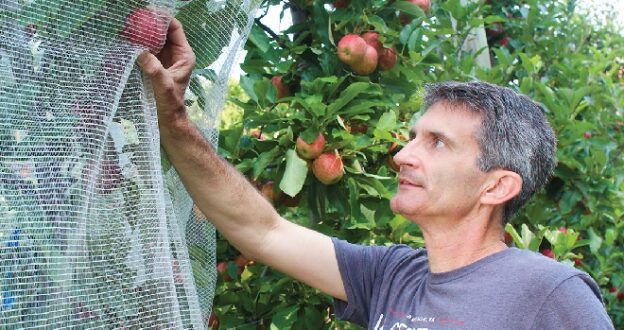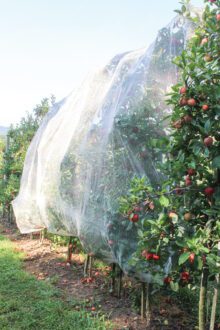

Jun 9, 2023Bug Barriers: Research studies netting effect on BMSB
Netting is being evaluated in apple orchards across the country. Sometimes it’s to protect the fruit from sunburn or hail, and sometimes it’s to improve thinning by keeping pollinators out. At North Carolina State University (NCSU), the focus is to exclude insect pests, and the target is the brown marmorated stink bug (BMSB).
“They fly fast, they can disperse widely, they drop to the ground when threatened — they have a lot of defenses. Developing a control is a very tough nut to crack,” said Jim Walgenbach, professor and Extension entomology specialist for fruits and vegetables in NCSU’s Department of Entomology and Plant Pathology.


NCSU researchers evaluated the effects of the netting as a protective barrier on trees located on both the edge and interior of the orchard.
The collaborative project, funded by the U.S. Department of Agriculture’s Specialty Crop Research Initiative, was completed in 2022 and involved more than 40 researchers from 18 institutions across the U.S. Walgenbach served as project leader.
The orchard was adjacent to a woodlot and the field edge was where BMSB damage was expected to be the highest. That’s the pattern most frequently found, especially in the mid-Atlantic states. The populations of the first-generation adults often build in woodlots and other areas adjacent to the orchard before dispersing into the fruit trees.
The intent of studying netting both on the edge and in the middle of the orchard was to test exclusion under high and low populations of BMSB. However, researchers found more BMSB injury on the trees in the middle of the orchard as opposed to trees in the border row.
“That’s not the first time we’ve seen it,” Walgenbach said. “You wouldn’t think it would happen that way because of where the BMSB populations build, but we’re farther south and haven’t seen a difference between interior and exterior populations.”
A reason could be a difference in the availability of hosts. The tree of heaven — one of BMSB’s preferred hosts — is common in North Carolina but is more prevalent in northern states. This could affect dispersion and how far the BMSB move.
Apple varieties vary in their susceptibility to BMSB damage. Granny Smith was the variety in the trial and is one of the more susceptible to damage when the first generation emerges.
Populations reduced, but economically viable?
BMSB populations were very high in North Carolina in 2021, the first year of the study. The orchard of Granny Smiths suffered nearly 50% damage in areas unprotected by the netting or insecticide sprays. The netting trials on the edge and in the middle of the orchard reduced the damage by about one-fourth, with an average of 36% damage between the two.
“Even though we did decrease damage with the netting, we still had unacceptable levels of damage,” Walgenbach said.
Insecticides weren’t used in the 2021 trial but were integrated into the netting program in 2022 to see if treatments would improve control and enhance the efficiency of the netting. Researchers compared no insecticide use to weekly insecticide applications and insecticide treatments based on thresholds.


There were drastic differences in BMSB populations between 2021 and 2022, with much lower pressure in 2022. Without insecticide use, researchers saw 8.5% damage with no netting and 6.6% with netting. Netting again reduced damage by about one-fourth.
“I’m not convinced the level of reduction is enough for the netting to be economically viable,” Walgenbach said.
Part of the challenge is the difficulty in securing the netting tight enough at ground level to keep the BMSB from getting under it. Researchers also saw no difference in weekly treatments versus treating at threshold, but definitive results were hard to come by.
“It’s very difficult to do small-plot, replicated trials on stink bugs because of their rapid dispersal,” Walgenbach said.
The BMSB can also ingest insecticide and still damage apples before they die.
Reducing BMSB populations on an area-wide basis to decrease the numbers dispersing into the orchard is the key. That means fostering biological controls, and a promising one is the samurai wasp (Trissolcus japonicus).
The samurai wasp evolved in Asia with the BMSB and was accidentally introduced into the U.S. The samurai wasp can pick up on chemical clues to find the BMSB and parasitize its eggs. The samurai wasp has been detected in about 15 states and continues to become more widely established every year.
The success of fostering beneficials like the samurai wasp depends on reducing the need for broad spectrum use of insecticides. Defining better thresholds on when to treat for BMSB would help with that.
“We initially thought pheromone traps would be a simple way to assess populations and determine thresholds, but we learned it’s not as straightforward as we anticipated, and there’s a lot more work to do,” Walgenbach said.
Traps only estimate populations in a very small area and are likely not reflective of population densities on a larger scale, which is complicated by the wide dispersal characteristics of BMSB.
Determining monitoring programs and understanding how pheromone trap captures can be used as decision-aid tools was one of the objectives of the BMSB project.
Project results and more information are posted on StopBMSB.org.
— Dean Peterson, FGN correspondent
Top photo: Researchers, including Steve Schoof, agricultural research specialist at NCSU’s Mountain Horticultural Crops, Research & Extension Center at Mills River, North Carolina, found netting reduced BMSB damage by about one-fourth in both high- and low-pressure years. Photo by Dean Peterson.














